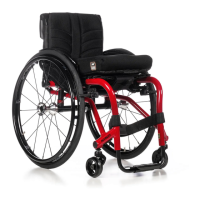23
ENGLISH
Nitrum / Nitrum Hybrid Rev.C
7.0 Disposal / Recycling of Materials
If the wheelchair has been made available to you free of
charge, then it does not belong to you. If it is no longer required,
then follow the instructions to return it as given by the
organisation that made the wheelchair available to you.
In the following section, there is a description of the materials
used on the wheelchair, in view of the disposal or recycling of
the wheelchair and its packaging.
Particular regulations with regard to disposal or recycling may
be in force locally and these must be taken into account when
performing disposal. (This can include the cleaning or
decontamination of the wheelchair prior to disposal).
Aluminium: Castor forks, wheels, sideguards for the chassis,
armrest frame, footrest, push handles
Steel: Fixing points, quick-release axle
Plastic: Handgrips, tube plugs, castor wheels, footplates,
armpads and 12” wheel/tyre
Packaging: Plastic bags made of soft polyethylene, cardboard
Upholstery:Woven polyester with PVC coatings and expanded
combustion modified foam.
Disposal or recycling should be done through a licensed agent
or authorised place of disposal. Alternatively your wheelchair
may be returned to your dealer for disposal.
Battery for LED Lights: Lithium Ion battery (hazardous
product)
Electrical and electronic equipment need to be disposed of
separately to general household waste at specific state-
provided locations. The correct disposal and separate collection
of used appliances serves to prevent potential damage to health
and the environment. It is a requirement for the re-utilisation
and recycling of used electrical and electronic equipment.
Detailed information on the disposal of your used equipment
can be obtained from your local authority, your waste disposal
service, the specialist dealer from which you purchased the
product, or your sales contact.
8.0 Trouble-shooting
Wheelchair pulls to one side
• Check tyre pressure
• Check to make sure wheel turns easily (bearings, axle)
• Check the castor angle
• Check to make sure both castors are making proper contact
with the ground.
Castors begin to wobble
• Check the castor angle
• Check to make sure all bolts are secure; tighten if necessary
(see the section on torque)
• Check to make sure both castors are making proper contact
with the ground.
Wheelchair / Cross-tube assembly does not snap into
position in the seat saddle
• Chair is still new, i.e., the seat or backrest upholstery is still
very stiff. This will improve with time.
Wheelchair is difficult to fold up:
• Adjustable backrest upholstery is too stiff. Loosen it
accordingly.
Wheelchair squeaks and rattles
• Check to make sure all bolts are secure; tighten if necessary
(see the section on torque)
• Apply small amount of lubrication to spots where movable parts
come into contact with one another
Wheelchair begins to wobble
• Check angle at which castors are set
• Check tyre pressure
• Check to see if rear wheels are adjusted differently.

